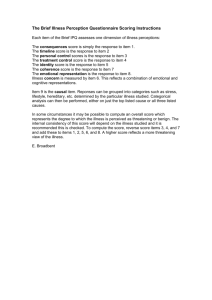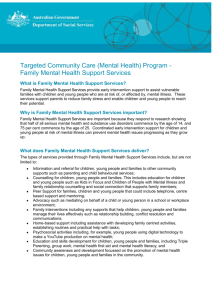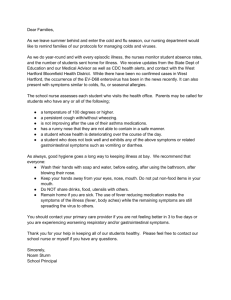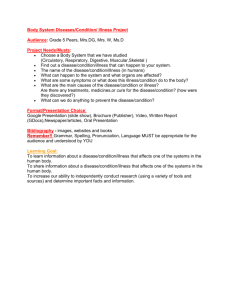Access by People with Mental Illness to Health Services
advertisement
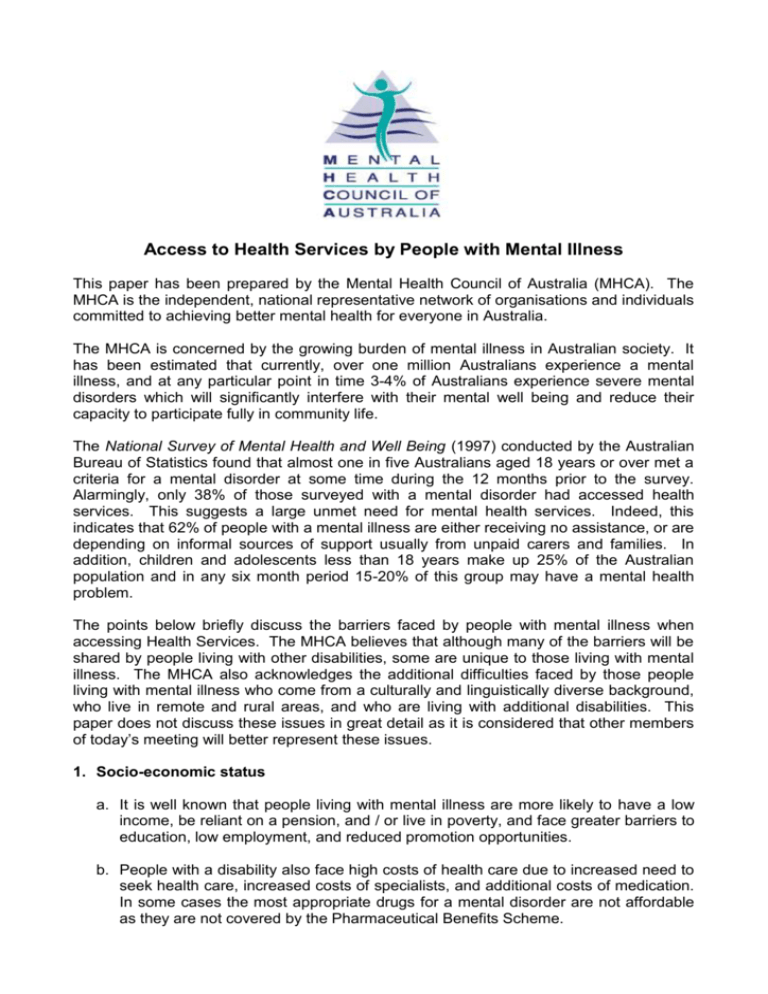
Access to Health Services by People with Mental Illness This paper has been prepared by the Mental Health Council of Australia (MHCA). The MHCA is the independent, national representative network of organisations and individuals committed to achieving better mental health for everyone in Australia. The MHCA is concerned by the growing burden of mental illness in Australian society. It has been estimated that currently, over one million Australians experience a mental illness, and at any particular point in time 3-4% of Australians experience severe mental disorders which will significantly interfere with their mental well being and reduce their capacity to participate fully in community life. The National Survey of Mental Health and Well Being (1997) conducted by the Australian Bureau of Statistics found that almost one in five Australians aged 18 years or over met a criteria for a mental disorder at some time during the 12 months prior to the survey. Alarmingly, only 38% of those surveyed with a mental disorder had accessed health services. This suggests a large unmet need for mental health services. Indeed, this indicates that 62% of people with a mental illness are either receiving no assistance, or are depending on informal sources of support usually from unpaid carers and families. In addition, children and adolescents less than 18 years make up 25% of the Australian population and in any six month period 15-20% of this group may have a mental health problem. The points below briefly discuss the barriers faced by people with mental illness when accessing Health Services. The MHCA believes that although many of the barriers will be shared by people living with other disabilities, some are unique to those living with mental illness. The MHCA also acknowledges the additional difficulties faced by those people living with mental illness who come from a culturally and linguistically diverse background, who live in remote and rural areas, and who are living with additional disabilities. This paper does not discuss these issues in great detail as it is considered that other members of today’s meeting will better represent these issues. 1. Socio-economic status a. It is well known that people living with mental illness are more likely to have a low income, be reliant on a pension, and / or live in poverty, and face greater barriers to education, low employment, and reduced promotion opportunities. b. People with a disability also face high costs of health care due to increased need to seek health care, increased costs of specialists, and additional costs of medication. In some cases the most appropriate drugs for a mental disorder are not affordable as they are not covered by the Pharmaceutical Benefits Scheme. c. People with mental illness are often limited to health providers who bulk bill (i.e. GPs). 2. Diagnosis – recognising and accepting there is a health problem a. Mental health problems are not always easily recognisable, and can remain unrecognised and therefore untreated. The stigma attached to mental illness and discrimination faced by people with mental illness acts as a significant disincentive to accepting there is a problem and seeking treatment. 3. The physical and mental health of people with mental illness a. People with mental illness have more physical illness than the general population. In 2001 the landmark study published in Western Australia, Duty to Care: Physical illness in people with mental illness1, identified people with mental illness as at higher risk of having a co-occurring physical illness, and of that physical illness going undiagnosed and untreated. The report indicated that death rates from all main causes amongst people with mental illness are 2.5 times higher than the general population, yet hospitalisation rates are considerably lower for many conditions2. b. People with mental illness are more likely to engage in high risk behaviour such as smoking, alcohol or drug abuse, and sexual promiscuity. c. People with mental illness are less likely to engage in health-promoting activities such as good diet and exercise. Barriers to these include the illness itself, expense, stigma, and side effects from medication. d. Additional stress, anger and frustration due to lack of services, stigma and discrimination have an adverse effect on people’s mental health. 4. Access to services a. Getting there - People living with mental illness often face significant difficulties in travelling to health services due to either their illness or the side effects of medication. This is particularly problematic in remote and rural areas where public transport is limited or unavailable. b. Communication barriers – People living with mental illness may also experience difficulty in absorbing complex information due to illness and / or medication sideeffects, which can affect their understanding of the illness, treatment compliance, and monitoring of their health. 5. Availability of services 1 Coghlan R, Lawrence D, Holman CDJ, Jablensky AV (2001) Duty to Care: Physical illness in people with mental illness. Perth: The University of Western Australia. 2 Although the rates quoted apply to Western Australia, they can be seen as indicative of rates in the rest of Australia. a. People in the community are often unaware of how to access mental health care or even what options are available. Even health professionals are often unaware of how to navigate the fragmented mental health systems operating in Australia. b. Except in acute episodes, GPs are usually the sole point of entry into mental health care, but this is dependent on accessing a GP with sufficient training and knowledge in the identification and treatment of mental health problems. c. Allied health professionals such as psychologists, occupational therapists and social workers are not covered by Medicare Benefits Schedule (MBS) subsidies. This can severely limits the access to the optimum treatment and care options required to achieve the best outcomes for those with a mental illness. d. Feedback from the community reveals that high value is placed on mental health care delivered through those GPs with the interest and training to do so. However, there are a number of significant barriers to accessing this care, such as declining rates of bulk billing and difficulties in identifying a GP with an interest and training in mental health care. Reliance on bulk billing also limits the ability of people with mental illness from finding a suitable GP and the situation is further exasperated by difficulties in getting a consultation, and then by limitations on GPs’ time for lengthy mental health consultations. Many mental health consumers reported great difficulty in getting short-notice access to GPs during a mental health crisis. 6. Workforce issues a. Attitudinal barriers from the health workforce can result in health professionals refusing to provide treatment to people with mental illness due to reasons such as lack of understanding of mental illness, fear and stigma. b. The mental health workforce faces high turnover and burnout rates. c. In 1997 the National Survey of Mental Health and Wellbeing3 first reported that 75% of people first seek help for a mental health problem from a GP. However, lack of mental health skills amongst health workforce, especially amongst GPs, is of frequent concern. d. The 1999 report The Specialist Psychiatry Workforce in Australia concluded that “the overall supply of psychiatrists is inadequate… and that without corrective action the workforce will move towards a situation of escalating undersupply.” Distribution of the specialist psychiatric workforce, especially psychiatrists, occurs unevenly throughout Australia. Remote and rural areas are particularly disadvantaged. There are unacceptably long waiting times for mental health consumers to see a psychiatrist in both the public and private sector. e. The exit of mental health specialists, especially psychiatrists, from the public workforce to enter the private sector following achieving qualifications is a further barrier to accessing care for many mental health consumers. 7. Service silos 3 Australian Medical Workforce Advisory Committee (1999), The Specialist Psychiatry Workforce in Australia, AMWAC Report 1999.7, Sydney, NSW. a. Refusal of some specialist services to treat people with complex comorbid disabilities creates significant service gaps, and people end up continually shifting between mental health services and other specialist services without ever receiving effective treatment from either. b. Lack of continuity of care both within the mental health system and between health and mental health services continues to be a major problem. c. Physical illness often goes undiagnosed and untreated in people with mental illness. Often mental health consumers are only receiving health care from specialists such as psychiatrists and psychologists, who may fail to diagnose a physical illness due to lack of training or attention to the consumer’s physical health. d. Likewise, mental illness often goes undiagnosed and untreated in people with physical or intellectual disability. As stated above, the loss of quality of life, as well as the additional strains such as stress, anger and frustration due to lack of services, stigma and discrimination can impact on the mental health of people with a disability. 8. Insurance discrimination a. It is well known that people with mental illness, or even people with incidence of mental illness in their family history, are frequently refused insurance products such as life insurance, health insurance, and travel insurance. b. It has been brought to the attention of the Mental Health Council of Australia (MHCA) that the Australian Government Department of Health and Ageing has recently approved a rule change to permit the private health insurance fund Australian Unity to limit for 12-months, full benefits for members who have transferred from another health fund and who wish to claim for psychiatric and rehabilitation services. Apparently, under this rule change members will be entitled only to “basic benefits”. It seems that this limitation is imposed regardless of whether these members have served the waiting period at another health fund, and is only imposed on those claiming for psychiatric and rehabilitation benefits. It is highly alarming that as of September 2004, the Federal Government will no longer be required to approve rule changes within specific health insurance policies. Providers will no longer have to seek authorisation from the Australian Government Department of Health and Ageing, only inform it of what policy changes have occurred. The implications for mental health consumers seeking psychiatric benefits from private health insurance providers is extremely grave. 9. Families and carers a. In early 2004 the National Family Carers Voice conducted a survey of over 1,000 family carers that identified structural and general impacts on family carers. The survey has raised serious concerns about the unmet needs of family carers themselves. Too often health services are not meeting the needs of consumers which places enormous pressures on family carers, who are placing their own needs last. The lack of services available for family carers themselves is also a significant problem, and as a result their health (both physical and mental) and quality of life are severely impacted upon. b. One of the greatest concerns identified amongst carers, particularly aging carers, is what will happen to the person they care for when they die. We do not have the systems and services available in the community to provide care for those consumers who are dependent on a family carer. The situation has now reached the crisis point that many carers are “afraid to die” because of what will happen to their loved one. Carers often unrecognised by health workforce c. Insufficient support for carers can lead to consequential effects on their physical and mental health. There are also flow on effects to children of parents with mental illness and other family members. 10. Forensic Services a. Mental illness is far more prevalent in people detained by the police for criminal behaviour than in the general community. However, this is misleading as often the inability of mental health services to provide timely and adequate care is resulting in some people with mental illness ending up in the forensic system, and therefore ending up in jail instead of receiving mental health care. b. The MHCA is concerned that access to mental health services for those people in Australian prisons is extremely limited and the needs of those requiring mental health services are neglected.


